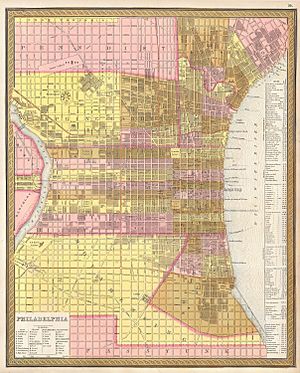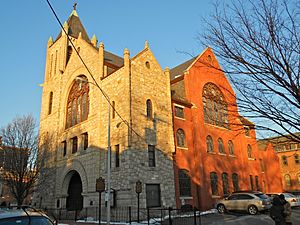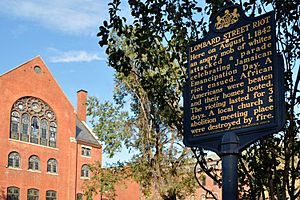Lombard Street riot facts for kids

The Lombard Street riot was a three-day event in Philadelphia, Pennsylvania, in 1842. It was a serious conflict between different groups of people. This riot was one of the last major outbreaks of violence like this in the city for about 13 years. It began on Lombard Street, between Fifth and Eighth streets.
Contents
Why the Riot Happened
In the early 1800s, Philadelphia's population changed a lot. Many African Americans, who were either freed or had escaped slavery, moved to the city. Philadelphia was seen as a safe place, just north of the Mason–Dixon line. Because of this, the city's black population grew by more than 50 percent in 25 years.
At the same time, many Irish immigrants also arrived in Philadelphia. These new groups often faced challenges and sometimes struggled to fit in. Both Irish immigrants and African Americans often competed for the lowest-paying jobs. This competition sometimes led to arguments and fights. Some Irish workers even refused to work alongside black workers. This tension created a difficult situation in the city.
The Riot Begins
The riot started on August 1, 1842. On that morning, more than 1,000 members of the black Young Men's Vigilant Association held a parade. They marched on Lombard Street to celebrate a special day: the eighth anniversary of the end of slavery in the British West Indies.
As the parade got close to Mother Bethel A.M.E. Church, an angry group of Irish people attacked them. The rioters then moved west, causing more trouble. They set fires and even attacked firefighters and police officers who tried to stop them. The rioters headed towards the home of Robert Purvis, a well-known African-American leader. Luckily, a Catholic priest stepped in and helped save Purvis and his home from the mob.
Damage and Response
During the three days of attacks, many buildings were damaged or destroyed. The Second African American Presbyterian Church, Smith's Hall (a place where people met to discuss ending slavery), and many homes were looted and burned. The mayor knew about plans to burn several local churches but did not act right away. Eventually, as the violence started to calm down, the local militia (a group of citizens trained as soldiers) was called in to bring order back to the city.
After the Riot
After the riot, Mayor John Morin Scott did not arrest most of the people known to have led the attacks. Of those who were arrested by the militia, most were later found not guilty or set free. The few people who were convicted received only light punishments. This made it difficult for the victims to get justice.
Remembering the Event
In March 2005, a special historical sign was approved to mark the Lombard Street Riot. This sign is located at Sixth and Lombard streets in Philadelphia.
The sign reads:
Lombard Street Riot — Here on August 1, 1842 an angry mob of whites attacked a parade celebrating Jamaican Emancipation Day. A riot ensued. African Americans were beaten and their homes looted. The rioting lasted for 3 days. A local church and abolition meeting place were destroyed by fire.
This marker exists thanks to a class of Philadelphia students. Their history teacher challenged them to research a race riot in the city and explain why it was important. After learning about the Lombard Street Riot, the students felt that this event was a key part of the city's history that was often forgotten. They worked to get the marker placed to show how racial intolerance had affected Philadelphia's past.
The marker stands in Starr Garden, which is Philadelphia's first public park and a popular playground today.



